The Glorious Golden Circle in Winter
By Katie Teeter
Iceland is winter is a veritable wonderland. What better time to explore the famed Golden Circle and experience the magnificence and awe of Gullfoss, Geysir and Thingvellir, than during arguably its most wild and spectacular season.
Nearly every visitor travelling to Iceland has heard of the Golden Circle, but may not be aware that it is something that you can do year-round. The Golden Circle is an easy day trip from Reykjavík, allowing you to experience a taste of the breath-taking landscapes, stunning nature, and unique history that Iceland has to offer.
While Iceland is beautiful year-round, winter brings an extra layer of natural wonder for your eyes to enjoy. The Golden Circle can easily be done as a self-drive tour, which gives you flexibility to visit each stop in your own time. Here are a list of our top spots, and the things we think you should know about taking on the Golden Circle in winter!
Safety first! Be prepared!
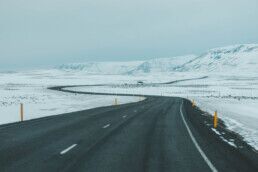
The road conditions are typically quite good for the Golden Circle, but it is always essential that you keep yourself updated with the latest weather and road conditions.
The best places to do this are www.vedur.is and www.safetravel.is Here you can find a map with the most updated conditions and any weather and travel notices.
If you are not confident driving in potentially icy or snowy conditions, there are many companies who organize guided bus tours as a safe and reliable option.
Most standard Golden Circle tours take around six hours, though if you are doing a self-drive tour you can of course choose to stay longer at the sites.
The three main stops in the Golden Circle are Þingvellir National Park, Geysir, and Gullfoss.
Before you set out on your day trip adventure, make sure that you are properly prepared.
In addition to checking the weather forecast and road conditions you should ensure that you have the proper clothing. During the winter it is better to stay on the safe side and bring sturdy hiking shoes and crampons.
Dress warmly with layers and remember to bring gloves, a hat, and a scarf. An extra pair of socks is never a bad idea in case your feet happen to get wet at one of the falls.
There are many places to stop for food and drink throughout the trip. Most places will have vegetarian and vegan options, but if you have any food sensitivities or specific dietary preferences then you should pack some snacks just in case.
For the duration of your trip in Iceland, remember that you do not need to buy bottled water. Everyone in Iceland drinks the tap water, and most places will be more than happy to help you re-fill your reusable bottle when needed. This reduces unnecessary plastic waste and helps you to save money.
Þingvellir National Park- a winter wonderland
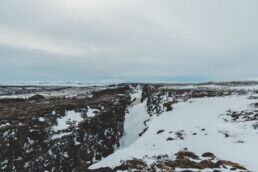
Þingvellir National Park, a UNESCO World Heritage site, is an area roughly 45 km from Reykjavík, and is your first stop.
It has important cultural, historical, and geological significance, making it a must-see location during your visit to Iceland.
Þingvellir is located in a rift valley where the North American and Eurasian tectonic plates meet, and you can walk a path between the two plates.
It is also notably the location of the founding of Iceland’s National Parliament, called the Alþingi, in 930. It served as an significant meeting place until the end of the 18th century, with the last meeting held in 1798.
There are three main parking lots at Þingvellir: one off of the main road, Þingvallavegur, and two on the lower side near the lake, off of Vallarvegur.
All three charge a small fee ranging from 750-1.000 ISK depending on the size of the vehicle.
There is a much smaller parking lot off of Þingvallavegur that is free, but it is not as regularly maintained and to get to the paved walking path you have to go down a short but steep and rocky trail that can be very icy during the winter months.
There is a Visitor’s Center off of the first parking lot on Þingvallavegur. It has an information center, a cafeteria, restrooms, and a small souvenir shop.
Another service center is located at the intersection of Þingvallavegur and Vallarvegur, which has more information on walking paths in the park.
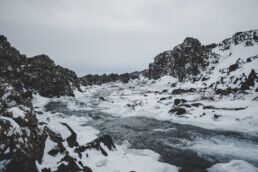
The first parking lot, located above the lake area, gives you beautiful scenic views.
During the winter months, the lake and surrounding area is often covered in snow and ice while snow-capped mountains completely surround you in the distance. It is an incredibly beautiful panorama.
You can then walk down on the footpaths into the Almannagjá fault. Walking between the plates is impressive enough, but if you follow the path you will reach a small waterfall called Öxarárfoss.
In the last few years the park has upgraded this area, so it is easily accessible and a wooden platform has been built by the waterfall. Every outdoor location can be slippery during the winter months, so watch your step and walk carefully.
Further down into the valley outside of the rift is Þingvallakirkja, one of the earliest churches in Iceland. The present church was built in 1859, but a church was constructed on the site shortly after Iceland’s conversion to Christianity in the 11th century.
The first church was built with timber and a bell donated by the Norwegian King Olaf. It continues to be an important historical site and is a frequent setting in Icelandic literature.
The church is not open on a set schedule during the winter, but guests can contact the park to see if a guided tour can be arranged ahead of time.
Geysir
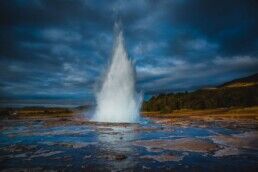
Your second stop is Geysir, a geothermal area located in the Haukadalur valley.
While the original Geysir itself is not currently active, the smaller Strökkur erupts every 6-10 minutes.
Strökkur shoots streams of water up 20-40 meters high, and the water around it is hot enough to boil an egg.
Icelanders outside of the city will bake the traditional rye bread, called rúgbrauð, in the ground in geothermal areas. The process usually takes around 24 hours, though it is not currently done at Geysir where there is a lot of foot traffic.
The surrounding area also shows interesting signs of geothermal activity, with bubbling mud pits and jets of steam emerging from rocky areas that have unique coloring.
The snowy hills and landscape around Geysir and Strökkur in winter is a beautiful contrast to the colourful and active hot spring areas.
Due to the spray from the eruptions, it can be very slippery on the walking paths so please tread carefully.
There are two parking lots, both free of charge. There is also a large gift shop and cafeteria, with plenty of restrooms inside. Geysir has arguably the best gift shop out of the three main stops on the Golden Circle.
Geysir lends its name to all springs that intermittently eject hot water and steam – geysers. The ‘original’ geyser, Geysir has been a tourist attraction since the late 18th/early 19th century.
The land where Geysir lies was originally owned by a farmer. The farmer sold the land to James Craig, an Irish whiskey distiller and the future Prime Minister of Northern Ireland, in 1894. Ever the entrepreneur, he built fences around the area and charged visitors a fee to view Geysir.
One year later he gave the land to a friend who halted the fees. His nephew later sold the property to Icelandic director and businessman Sigurður Jónasson in 1935. Sigurður then donated it to the Icelandic state in the hopes that it would become a national park.
Geysir made news in recent years when, in 2014, local landowners began charging an entry fee once again. While the land that Geysir stands on is owned by the government, the surrounding area is privately owned. This was declared illegal in 2015 and remains free to visit today.
There are roughly 30 geysers of varying sizes in the area. Strökkur is the one featured in most of the photographs that you find online and in brochures, though there is another notable tiny geyser called ‘Litli Geysir’, or Little Geysir.
Earthquakes can awaken Geysir, with notable activity in 1630, 1845, and 1896. In 1910 Geysir was erupting every 30 minutes, but soon the eruptions faded away once more. In the 1980’s and 1990’s, Icelanders caused Geysir to erupt using soap to emulate earthquakes, especially for Iceland‘s National Day, June 17th.
Another earthquake in 2000 set Geysir off again, with water reaching 122 meters (roughly 400 feet) in height. The activity today is once again very low, but there is always a chance that Geysir will rise again!
PLAN YOUR JOURNEY
Travelling to Iceland?
Check our overnight tours with a driver guide that includes a one night stay in a bubble.*Starting from ISK 74.900 per person
Gullfoss- frozen falls
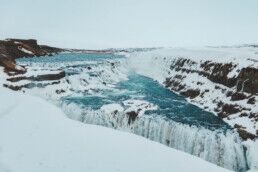
Finally, the last stop on the Golden Circle is Gullfoss, one of Iceland’s most famous waterfalls.
Gullfoss is spectacularly beautiful in the winter with the low winter sun reflecting off of the snow and ice that cover the surrounding canyon.
Many would argue that Gullfoss especially is its most beautiful during the winter months. The meaning of Gullfoss is ‘golden falls’, likely due to the golden hue that the sun casts on the spray from the falls.
In good conditions a rainbow can often be seen above the waterfall.
Much work has recently been done to improve the walking paths, but it is good to be careful and watch your step for potential icy patches at all of the locations.
There are upper and lower parking lots with walking paths that lead to the same location, but with different views.
Gullfoss, like nearly every major attraction in Iceland, has well-marked walking paths with signs saying which areas are off-limit. Please respect these areas – this is both for your safety, especially during winter, and to protect the surrounding nature and environment.
As Iceland happily welcomes an increase of tourists, we must all be responsible to ensure that these areas remain free and well-maintained for generations to come.
The waterfall is located along the Hvítá river and has two main drops – the first is roughly 11 meters, and the second 21 meters. During the summer months the water flows at an average pace of 141 cubic meters/second, and during the winter the average is around 80 cubic meters/second.
No matter what time of year you visit, hearing the powerful roar of the waterfall is massively impressive and makes you aware of how powerful the falls are.
One of the more unique aspects of this waterfall is that most of the main viewing points are from the top of the falls instead of from the bottom.
Other walking paths are located around the area, but can be closed off depending on the weather (snow, rain, or ice) or trail quality.
As a final precaution, it is recommended to bring crampons during the winter months if you plan on getting close to the falls.
Gullfoss is now one of the top three visited natural locations in Iceland, but just over 100 years ago it almost became the location of a dam for hydroelectric power. Both foreign and Icelandic investors expressed interest in the project.
Perhaps the most famous story surrounding Gullfoss is that of its protector, Sigríður Tómasdóttir. Born in Brattholt, a farming area around Gullfoss, Sigríður and her siblings grew up around the river and falls. It is said that they acted as tour guides for some of the many people who journeyed to see Gullfoss.
In the very beginning of the 1900’s Sigríður’s father and other landowners agreed to allow a hydroelectric dam to be built, which would have submerged Gullfoss. Sigríður was understandably upset, and this is where her journey begins.
Sigríður worked for years to save Gullfoss. She made many journeys to Reykjavík, 120 km away, either by horse or on on foot.
She staged protests, filed formal legal complaints, met with government officials, and is rumoured to have threatened to throw herself into the river. Her claims did not hold up from a legal standpoint in court but she gained great public attention and support.
The contracts were later cancelled and the hydroelectric dam was never built. Gullfoss and the surrounding area was sold to the Icelandic government and granted formal protection in the form of permanent conservation in 1979.
You can see a sculpture of Sigríður nearby the waterfall during your visit.
Thanks to Sigríður and the Icelandic government, visitors can continue to enjoy Gullfoss for free.
The visitor’s center at Gullfoss has restrooms, a gift shop, and a restaurant with views overlooking the falls. Their hours are usually from 9:30-18:30, though they may change due to holidays or weather.
Access to the waterfall is free of charge and the parking area and walking path are open 24/7. There are public restrooms at Gullfoss, but you need to pay a small fee to use them. If you have purchased something from the restaurant then you are welcome to use the restroom inside for free.
Next stop...
In addition to these classic Golden Circle stops, there are many other wonderful places to stop along the way depending on your interests and time frame.
The main road for the Golden Circle has many different vista points where you can stop to take photographs and admire the scenery. There are also other smaller waterfalls, craters, and local companies to visit.
Often included in extended Golden Circle tours, Kerið is a 3000-year-old volcanic crater lake located in the Grímsnes region.
During the winter months, the red volcanic rock is often dusted with snow and the lake partially frozen over. It has a completely different landscape than the summer months, giving you a unique perspective that most visitors to Iceland will miss.
It is an easy addition to your self-drive tour as it is just off of highway 35. There is a small car park and in recent years, a modest fee has been charged to help the landowners maintain the area and walking path due to increased interest from visitors.
Faxi Waterfall is another simple and straightforward addition to your self-drive tour. Just 12 kilometres from Geysir and Gullfoss, it is easily accessible year-round.
At 80 meters wide and seven meters high, it is sometimes called a miniature Gullfoss. You can also get much closer to this waterfall than you can to Gullfoss, and there are fantastic photo opportunities from upper and lower levels.
Ways to warm up
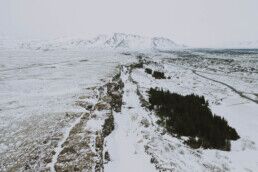
The Friðheimar Greenhouse may also be of interest to some visitors. The greenhouses are often included in longer Golden Circle tours, and it is an excellent place to stop for lunch.
Friðheimar is famous for their locally grown tomatoes and cucumbers. You can take a tour to see how they grow produce using geothermal water, hydroelectricity, and the help of bees.
The tours must be booked in advance, but even if you do not tour it is a very cosy and interesting stop. They are able to grow produce year-round and their restaurant is open from 12:00-16:00 every day.
You can try the delicious tomato soup, tomato beer, and even tomato ice cream! Their restaurant is located inside the main greenhouse, so you can step in to warm up and relax in a unique setting while snow gently falls outside.
Efstidalur farm is located right in the middle of the Golden Circle, and is family owned and operated. These experienced dairy farmers have been living on the property for 7 generations.
Originally, they were exclusively dairy farmers, but in 2002 began expanding alongside Icelandic tourism. They offer a variety of milk products, notably their own ice cream.
You can stop by the farm to see how an Icelandic dairy farm operates, say hello to the many farm animals including cows, horses, chickens, dogs, cats, and a pig, and get a taste of extremely fresh and delicious Icelandic ice cream.
Ice cream is a popular treat for Icelanders year-round, so enjoying an ice cream cone while it is snowing outside is really a traditional Icelandic experience.
Laugarvatn Fontana Spa is another great addition to your Golden Circle tour to help you wind down after a day of exploring.
Located in the small town of Laugarvatn just off a large lake, these warm baths offer a relaxing soak in the natural geothermal waters. You can also visit the steam room or jump straight in the icy lake for a refreshing shock!
They are open year-round, though their winter hours can vary. They recommend booking a day in advance on their website, www.fontana.is/en.
This is a quiet, small, and lesser-known geothermal pool with beautiful views across the lake and the mountains that surround it.
You can also try your luck at seeing the Northern Lights from this location – seeing the lights while in a hot pot with a drink in your hand is a wonderful way to end the day.
The magic of Icelandic winter
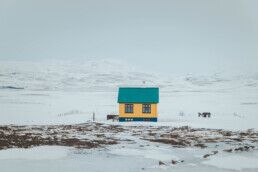
It is important to remember that Iceland has shortened daylight hours in winter, so plan your trip accordingly to allow daylight at each location. Depending on what time you head back to your accommodation, you may get lucky and see the Northern Lights.
The best months to view the lights in Iceland are from the end of August to mid-April, and if conditions are right, being out of the city gives you the best chance to catch them.
The most important thing to look for when searching for the auroras are clear skies. The activity scale can also be a helpful indicator of which nights will have the most activity, but you still need to be lucky and in the right place at the right time.
There are many websites to help you stay up-to-date with the northern lights forecast, with the best local one being www.en.vedur.is.
With some luck, you will be able to end a fantastic Golden Circle day tour watching the aurora borealis dance above a winter wonderland.
White gold- final tips..

So remember our key tips before you take on the most famous route in Iceland:
- Always check the road conditions and weather
- Layer up in appropriate winter clothing
- And keep your eyes on the skies after dark!
We hope that this information allows you to plan your ideal Golden Circle trip during your stay in Iceland, and The Five Million Star Hotel may just be the perfect place to rest your head after your adventures.
Winter on the island can be cold, windy, and absolutely stunning. You will see and experience winter in an entirely new way, with plenty of stops to photograph your journey. Stay safe and enjoy!
PLAN YOUR JOURNEY
Travelling to Iceland?
Check our overnight tours with a driver guide that includes a one night stay in a bubble.*Starting from ISK 74.900 per person